Final Report for GNE14-091
Project Information
As farmers in the northeast face ever-mounting pressure and desire to protect water quality, increase soil health, and maintain productive and sustainable farms, they are increasingly turning to cover crops as a way to accomplish these goals. By far the most common cover crop utilized by dairy and forage crop farmers in Vermont is winter rye seeded after corn silage. With our short growing seasons, winter rye has become a dependable cover crop to provide good erosion control and nutrient cycling. However, as more producers become aware of alternative cover crop species and mixtures of species, they are asking to know more about their choices and what the potential benefits may be to planting these alternative crops. This study evaluated whether the addition of forage radish (Raphunus sativus L. var. longipinnatus) to a winter rye (Secale cereale) cover crop could augment and enhance the cover crop performance over winter rye by itself. In addition, it quantifies the economic impacts of this combination and basic agronomic recommendations for seeding rates and establishment methods of winter rye and winter rye-radish combinations.
This field experiment occurred on four different fields on two farms over the course of two seasons, 2014/2015 and 2015/2016. Five cover crop treatments and a control were both no-till drilled and broadcast (for a total of ten treatments combinations plus a control) after timely corn silage harvest and then received one application of liquid dairy manure immediately after planting. Measurements occurred the fall after planting and the subsequent spring. Not all data has been analyzed, but so far the most significant differences (in biomass and percent cover) are a result of planting method, with drilled plots performing significantly better than broadcast plots overall.
Results were shared with farmers, university faculty/staff/students, and ag service providers in Vermont and around the northeast. There was a large Extension/outreach component to this project. This project was also part of a larger USDA-NIFA project (2014-68006-21864).
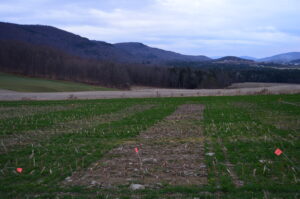
Research Plots (SY 4)
Introduction:
Since 2012, Vermont dairy and forage crop producers have rapidly adopted cover cropping as a conservation practice, increasing their use of cover crops from very few acres annually to over 25,000 acres planted in the fall of 2016. Increasing awareness of soil health, water quality, and nutrient management is driving this adoption. However, farmers are interested in new information and strategies to add cover crops to their corn silage cropping systems.
In a recent cover crop survey of Vermont farmers being conducted by Lindsey Ruhl (SARE Graduate Student Project grantee, GNE12-045) and the Project Coordinator, producers selected the top three questions they would like to see addressed through research in Vermont as: varieties/species of cover crops (48% of respondents), cover crop mixtures (40 %), and seeding rates (37 %). This project addressed all three of these research areas. In addition, the Vermont NRCS recently updated their Cover Crop Practice Specification to include mixtures and seeding rates, although many of these are based on New York recommendations and have yet to be tested in Vermont. This project also provides data to evaluate, update and/or modify these conservation practice requirements.
Since 2004 and before, there has been a growing body of research quantifying the benefits of forage radish as a cover crop. It has been shown to excel in the agroecosytem functions of weed suppression, nutrient uptake, biomass production, and compaction relief. Dr. Ray Weil (University of Maryland) and Dr. Charlie White (Penn State) have pioneered much of this work. Commercially, Steve Groff’s Tillage Radish® has become the cornerstone of an entire company based on growing cover crops. Many of these projects have been funded by SARE in the past. A recently completed NE SARE Partnership Project looking at Cover Crop Diversity in No-Till Systems (ONE13-177) found that our cover crop mixes that include brassicas have higher nutrient uptake and more fall biomass than winter rye by itself. They can also match or outperform winter rye for fall soil coverage, an important factor for soil erosion prevention and associated nutrient losses into surface waters.
Although there is sound research on the benefits of winter rye and forage radishes as cover crops, there has not been a direct investigation on the combination of these two crops together. This project compliments concurrent work being done by Sarah Hirsh and Dr. Ray Weil in Maryland and Pennsylvania (SARE LNE14-338) by comparing the performance of winter rye by itself to various combinations of winter rye and forage radish in a northern corn silage system will fall applications of dairy manure. Because growers in Lake Champlain Basin and Vermont are regulated for phosphorus applications and so many farms are dairies that utilize manure in their crop production systems; we will be looking at nitrogen, phosphorus (and potassium). In addition, we evaluated appropriate seeding rates and methods for farmers utilizing a combination of forage radish and winter rye cover crops after corn silage harvest in our cooler, northern climate.
This project is part of a larger USDA-NIFA grant (2014-68006-21864). That grant ends in July 2017 and final data analysis will be complete at that time. It also occurred simultaneously with a Vermont NRCS Conservation Innovation Grant assessing ten three-way cover crop mixes interseeded into corn and soy crops and drilled after those crops were harvested.
Objective 1: Determine the effects of combining forage radish with winter rye cover crops and evaluate if the addition of forage radish has impacts on: overall performance of the cover crop, improved nutrient uptake and enhanced ecosystem services.
This objective was completed. Data was collected evaluating overall performance, nutrient uptake and ecosystem services. See Results & Discussion (Milestones) and Impact of Results (Outcomes) sections for a detailed discussion.
Objective 2: Establish the proper seeding rates and planting methods for a forage radish/winter rye cover crop in a corn silage system with manure.
This objective was completed. It is clear from the data that drilling cover crops (regardless of seeding rate or manure application) is far superior to broadcasting them on the soil surface. Within the drilled treatments, there was little difference (if any) between seeding rates of winter rye and inclusion of radish, suggesting that when planting with a drill in early to mid-September can utilize much lower seeding rates than currently required. See Results & Discussion (Milestones) and Impact of Results (Outcomes) sections for a detailed discussion.
Objective 3: Quantify the economic impact of different cover crop treatments, both seeding rates/composition and application methods.
This objective was completed. See Economic Analysis Section for a detailed discussion.
Objective 4: Promote and increase the use of cover crops and share project findings through direct farmer outreach with field days, newsletter articles, social media, Extension fact sheets and presentations. Provide research-based data to support of modify existing cover cropping specifications used by technical service providers and cost-share funding agencies.
This objective was completed. See Publications/Outreach and Farmer Adoption sections for a detailed discussion of the activities undertaken for this project.
Cooperators
Research
Experimental Design
This research project was a randomized complete block design, with four replications. We planted the experimental plots in two fields each year, for four fields total. Each field is a site year. Two farms located in Addison County, Vermont hosted these experiments during the cover crop seasons 2014-2015 and 2015-2016. Cover Crop treatments were planted after corn silage harvest by either broadcasting on the surface or planting with a no-till grain drill. Plots were either 92.9 or 46.5 . Manure was spread on plots (3 out of 4 site years) after the cover crop was planted, but before it germinated. See the attached document, “Plot Maps – All Sites” for diagrams of the experiments, plot layout and treatments.
Treatments
Treatments included: rates of winter rye, with or without forage radish, and drill or broadcast planting method. The treatment combinations in Table 1 were replicated four times in a randomized complete block design. See the attached document, “Plot Maps – All Sites” for diagrams of the experiments, plot layout and treatments. Treatments were selected based on current NRCS specifications for seeding rates based on planting method. Table 2 outlines those specifications
Table 1. Cover Crop Treatment Combinations (All Site Years)
|
Treatment Code |
Winter Rye (kg ha-1) |
Radish (kg ha-1) |
Planting Method |
|
Control |
0 |
0 |
- |
|
112Rye_0Rad_B |
125 |
0 |
Broadcast |
|
112Rye_0Rad_D |
125 |
0 |
Drill |
|
85Rye_0Rad_B |
95 |
0 |
Broadcast |
|
85Rye_0Rad_D |
95 |
0 |
Drill |
|
85Rye_3Rad_B |
95 |
4 |
Broadcast |
|
85Rye_3Rad_D |
95 |
4 |
Drill |
|
60Rye_ORad_B |
67 |
0 |
Broadcast |
|
60Rye_0Rad_D |
67 |
0 |
Drill |
|
60Rye_3Rad_B |
67 |
4 |
Broadcast |
|
60Rye_3Rad_D |
67 |
4 |
Drill |
Table 2. Vermont NRCS Specifications for winter rye and forage radish cover crops (from NRCS eFOTG, )
|
Cover Crop |
Broadcast(include aerial apply) Minimum Seeding Rate (lbs./acre) |
Drilled or Planted Minimum Seeding Rate (lbs./acre) |
Latest Seeding Date |
|
Winter Rye |
112 |
75 |
October 1 |
|
Forage Radish |
15 |
10 |
September 1 |
|
Winter Rye/ Forage Radish |
85/4 |
60/3 |
September 15 |
Planting Methods
Broadcast plots were seeded by hand with an EarthWay Bag Seeder. Seed was premeasured at the correct amount for the plot size and then broadcast onto the soil surface with multiple passes. Drilled plots were planted with a Haybuster 107c No-Till Drill that was calibrated prior to planting. Winter rye was planted through the large grain seed box while the radish was planted through the small seed box. This allowed for more accurate calibration and depth placement of seed, rather than mixing the seed together. All plots were planted to the target seeding rate based on pure live seed to account for differences in percent pure seed and germination rates during different years and seed lots. Within a season, we used the same seed lots. All seed was certified seed with named varieties - Winter Rye (‘Danko’) from SeedWay (Hall, NY) and forage radish (‘Tillage Radish® CCS-779’) from Cover Crop Solutions, distributed by T.A. Seeds (Avis, PA).
Manure
Custom operators hired by participating farm partners surface applied liquid dairy manure across plots after the cover crop was planted (perpendicular to the treatments). The target rate was 5,000 gallons per acre. We quantified application rates for each pass using a pan designed to capture liquid dairy manure. The pan is set in the middle of the spreader pass, capturing manure as spread. We then used a known quantity of water to wash the manure out of the pan. Manure and water was weighed and then water weight subtracted to get a net weight of manure. At the time of spreading we also weighed manure samples to establish density. We then use the density and net manure weight, along with the known area of the pan to establish a spreading rate in gallons per acre. Manure samples collected at the time of spreading were also sent to the University of Maine lab for analysis of nutrient content. This was then used to estimate the amount of nitrogen, phosphorus and potassium applied per acre.
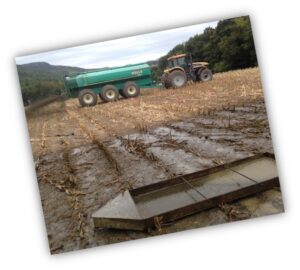
Manure being spread across Rye-Radish cover crop plots (SY 2)
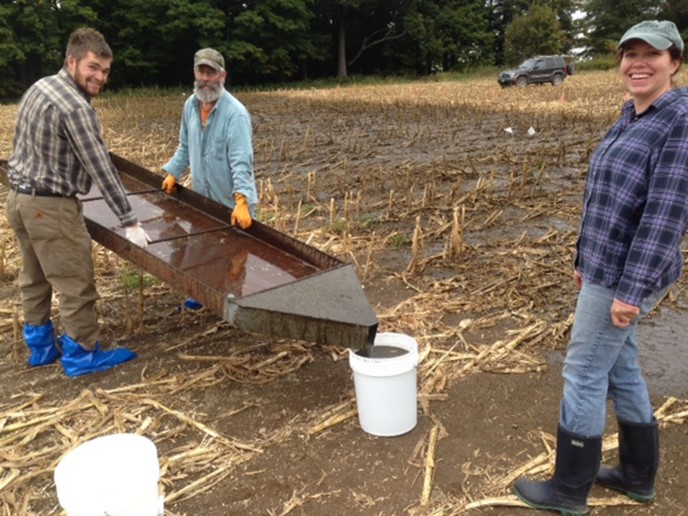
Measuring a manure application (SY 2)
Study sites
All four site years were located in different fields on two different farms in Addison County. With different soil types, seasons, manure applications and overall management each site will be analyzed separately. However, the different attributes of each study site are described in the table below.
Table 2. Site Descriptions
|
SY 1 |
SY 2 |
SY 3 |
SY 4 |
|
|
Soil Type |
Candagua silt loam |
Stetson gravelly sandy loam |
Vergennes clay |
Stetson gravelly sandy loam |
|
Date Cover Crops Planted |
19-Sep-2014 |
19-Sep-2014 |
9-Sep-2015 |
23-Sep-2015 |
|
Date Manure Applied |
23-Sep-2014 |
23-Sep-2014 |
11-Sep-2015 |
-- |
|
Date Cover Crops Terminated* |
14-May-2015 |
5-May-2015 |
29-Apr-2016 |
6-May-2016 |
|
Manure (gallons/ac.) |
7,287 |
6,003 |
3,770 |
-- |
|
Manure nutrients applied |
|
|
||
|
Ammonium N (NH4+) (kg ha-1) |
86.2 |
59.9 |
43.5 |
-- |
|
Organic N (kg ha-1) |
123.2 |
101.5 |
84.1 |
-- |
|
Phosphorus (kg ha-1) |
37.9 |
31.3 |
14.1 |
-- |
|
Potassium kg ha-1 |
179.9 |
148.3 |
103.9 |
-- |
|
Tillage System prior to experiment** |
Spring Tillage |
Spring Tillage |
No-Till |
No-Till |
|
* |
last data collected, plots physically terminated soon after |
|||
|
** |
no tillage between corn and when plots were planted |
|||
Percent Cover
Percent cover is a measure of the percent of the soil surface with plant residue. We utilized the NRCS Line Transect Method for Estimating Crop Residue Cover. This measurement quantifies the cover crops’ ability to reduce erosion by preventing raindrops and snowmelt from having direct contact with the soil surface. NRCS utilizes estimates of percent cover measured with this method for determining the impact of residue on sheet and rill erosion. By using this method, we quantified all crop residue. This included corn silage stubble, weeds and any other plant residues. By including a control plot, we felt that this accurately accounted for the effects provided by the cover crop treatments. We used a Cam-Line, nylon-coated, stainless steel, wind-resistant cable with measuring grommets stamped on line at 1’ intervals. The line was laid diagonally across plots in 15-foot lengths. At each one-foot spaced grommet, a visual determination was made whether there was any crop residue touching that point. If there was crop residue observed, it was recorded. This procedure was repeated three times for each plot to get an average percent cover by dividing the total number of points with residue transecting them by the total number of points possible. This measurement was taken twice in the fall and once or twice in the spring, depending on site year conditions.
Biomass & Tissue Analysis
Biomass of the cover crop gives us a measure of the success or ‘performance’ of the cover crop and its ability to capture nutrients. Biomass was quantified by clipping multiple 0.14 quadrats (6 in fall, 4 in spring) of leaf tissue, placing the sub-samples in a cotton bag together, and drying at 43.3 degrees Celsius (110 degrees Fahrenheit) for multiple days until all moisture is driven off. Dried samples were weighed and those measurements were used to determine biomass in kilograms per hectare. These same dried samples were then ground on a Wiley® cutting mill to 2 mm. These dried and milled samples were sent to Dairy One Forage Lab (Ithaca, NY) for wet chemistry mineral analysis for percent crude protein (used to calculate percent nitrogen), phosphorus and potassium. This analysis together with biomass measurements were used to calculate nutrient uptake of the cover crop in kilograms per hectare.
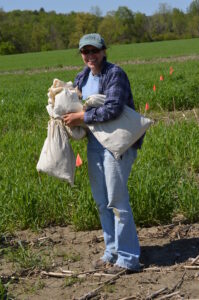
Collecting forage samples in the spring
Soil Analysis
Each block/replicate within an experiment (site year) was soil tested for baseline conditions in the fall prior to planting and/or manure application. Samples were collected using a JMC Soil Probe to collect 12-15 sub-samples at 6-8 inches depth, mixed together, and collected a composite sample to be analyzed. Samples were analyzed at the University of Maine Lab for nutrient content and other criteria (organic matter, cation exchange capacity, etc). Each individual plot was then sampled in the spring, just prior to termination, for the same parameters, using the same methods described above. In addition, samples were collected at 12 inch depth according the same protocol described earlier in order to analyze plant available nitrogen. Samples were collected, placed in a cooler, and then taken to the University of Vermont Agriculture and Environmental Testing Lab. Samples were prepped and placed in the lab ovens immediately by project staff in order to facilitate immediate drying. Laboratory staff then analyzed samples according to protocol. Samples were analyzed for NO3- and NH4+ and reported in mg/kg. Soil nitrogen samples were collected twice in the spring prior to termination, roughly two weeks apart.
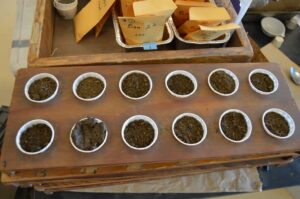
prepping soil nitrogen samples
Soil Moisture
Soil moisture was measured by collecting percent volumetric water content readings using a Spectrum® Technologies FieldScout TDR 300 Soil Moisture Meter with 12cm rods. In the Stetson and Canadagua soils, the standard mode was used, while in the Vergennes soil the high clay mode was used. The meter was calibrated before each sampling session, according to manufacturer recommendations. We took five readings in each plot to get an average percent soil moisture for the plot. We measured soil moisture once in the fall and twice in the spring.
Soil Temperature
Soil temperature data was collected using a Hanna Instruments HI145-01 digital thermometer at a 0.1 degree Fahrenheit resolution. The meters calibrate every time they power on and are accurate within +/- 0.6 degrees Fahrenheit. We took readings at 2-inch and 4.5-inch depths, with five readings per plot to get an average reading for the plot. Soil temperature was measured twice in the spring, correlated with soil nitrogen sampling.
Air Temperature (Growing Degree Days)
Air temperature data was collected using Spectrum® Technologies Watch Dog A-Series Loggers. Loggers were programmed to read air temperature every half hour. Two loggers were placed at each site, per manufacturer instructions, inside radiation shields and roughly 4 feet above ground level. They were deployed when plots were planted, taken down during the coldest parts of winter and redeployed in the spring, until plots were terminated. Data was downloaded to SpecWare 9 Basic Software and analyzed to compute growing degree days, base 40 degrees Fahrenheit.
Data Analysis
Not all the data has been analyzed yet, as the Project Coordinator is in the process of writing her thesis currently. However, preliminary analysis is well underway. All statistical calculations thus far have been performed using JMP Pro 12 (SAS Institute Inc.). Further analysis will be performed with SAS 9.4 (SAS Institute) with assistance from a University of Vermont statistician. Analysis of Variance (ANOVA) was used to test for treatment effects. If a treatment effect was determined to be significant, Tukey’s Honestly Significant Difference (HSD) test was used to compare treatment differences. Because each site year was in a different location, with different attributes, seasons varied with weather, and not all sites received manure applications, data was not pooled across site years but analyzed separately. All analysis was performed at the .05 level of significance.
Not all data has been analyzed for this project yet, as the Project Coordinator is currently writing her Master’s thesis based on this data. In addition the USDA-NIFA grant that also funded this work ends in July, and data will be used in the completion of that report as well. This report will focus on the cover crop biomass and percent cover data, as that is where the most significant results were found.
Cover Crop Biomass
Biomass was measured in the fall at projected peak fall biomass accumulation to capture fall performance and again in the spring just prior to termination to capture final biomass accumulation. Table 1 and associated charts show this data by site year.
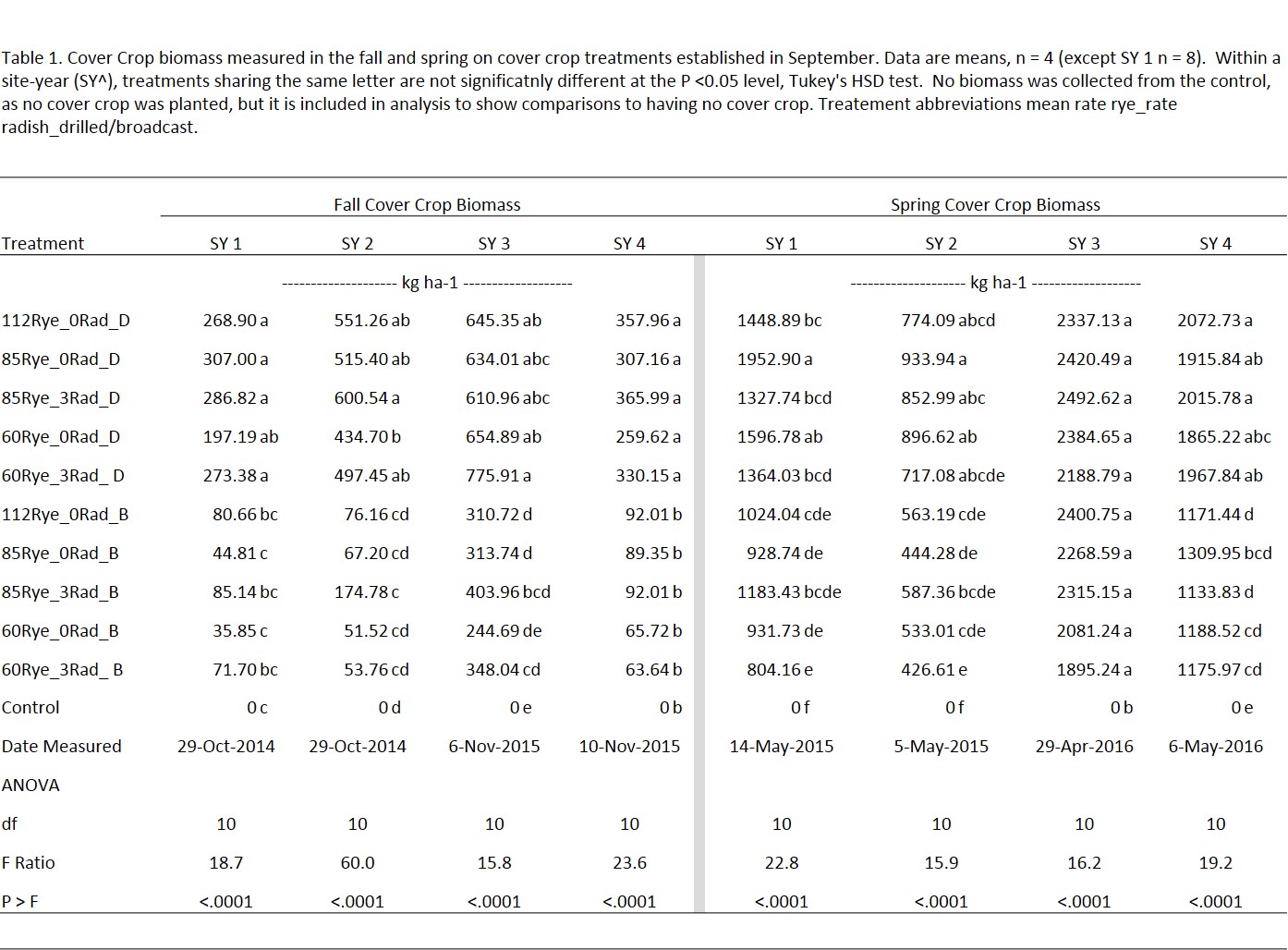 Table 1. Cover Crop Biomass (Fall & Spring) by Site-Year
Table 1. Cover Crop Biomass (Fall & Spring) by Site-Year
Table-1-and-associated-charts_Biomass
The most striking result is that all drilled treatments performed significantly better than their broadcast counterparts. See Figure 1 for a visual display of what this looked like in the plots. This was true for all site-years in the fall measurements and all but one site-year (SY 3) in the spring. SY 3 spring biomass measurements had no significant difference between treatments, other than between all cover crop treatments and the control. This site had particularly good establishment and the winter of 2015-2016 was particularly warm, seeing temperatures in the 60s up into December. This seemed to mask any differences between treatments in the spring on that site. While not statistically significant, it was interesting to see that the highest rate (112 lbs./ac.) of winter rye did not always come out on top, in either the fall or spring. In fact, it was only the top performer in the spring in one site-year (SY 4). In the fall, there were some broadcast treatments that did not perform significantly better than the 0 kg ha-1 results of planting no cover crop at all. Radish did not have an impact on biomass with any significance. It seemed to vary depending on site-year and season whether treatments with radish performed better or worse than the winter rye only counterparts. Further analysis will be done looking at drilled plots, based on this data, to look at the nuances of the radish on the performance of the cover crop for nutrient cycling (both crop uptake and soil nutrient status). It did seem to generally have the most effect (although not significant) at the lowest winter rye seeding rate (60 lbs./ac.)Figure 2 shows an example of what a single rate of rye with and without radish looked like in the fall and spring. Biomass measurements ranged from 63.64 kg ha-1 to 775.91 kg ha-1 in the fall and 426.61 kg ha-1 to 2,492.62 kg ha-1 in the spring.
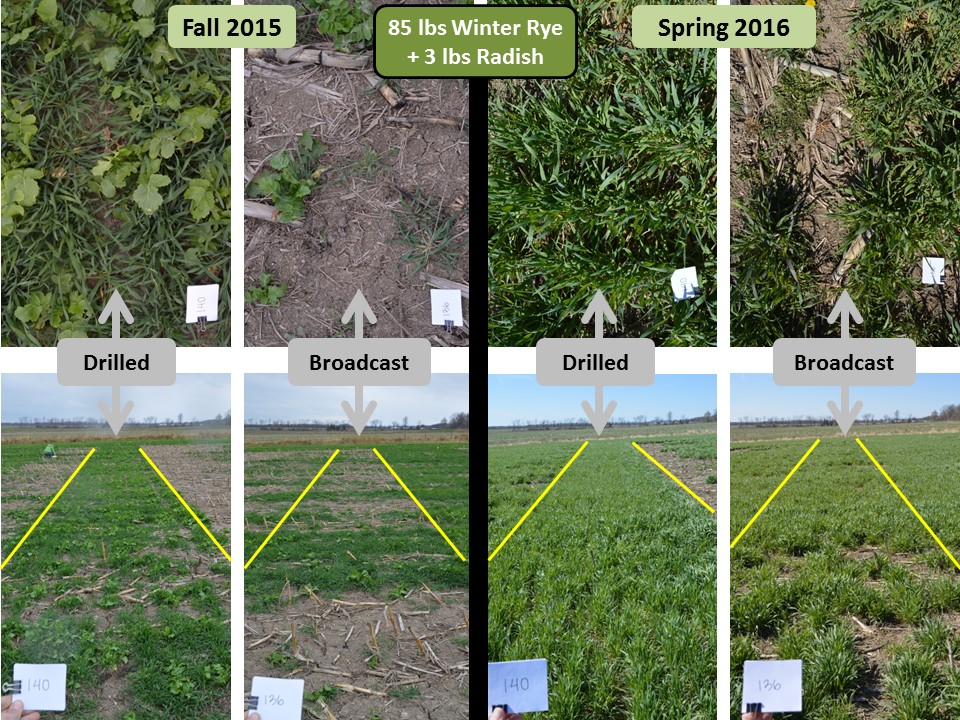
Figure 1: Drilled versus Broadcast
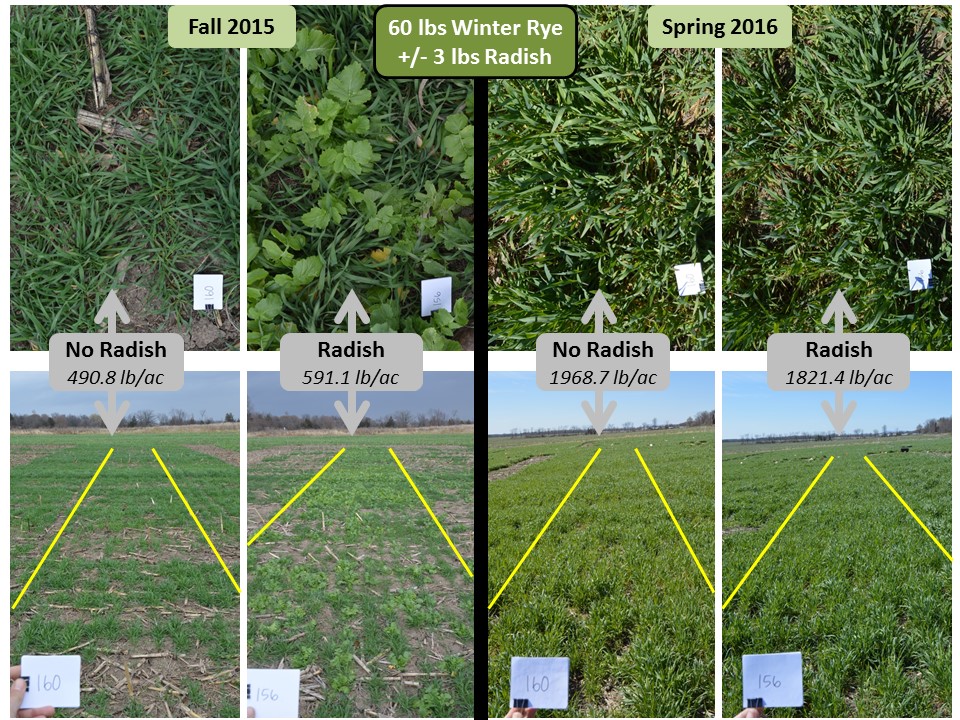 Figure 2: Radish versus no radish
Figure 2: Radish versus no radish
Crop Residue Percent Cover
Percent cover of all crop residue (see Materials & Methods section) was also measured in the fall and the spring, with the same rationale as the biomass sampling. Similarly, percent cover showed the most significant differences based on planting method, drilled versus broadcast, rather than the seeding rate or presence of radish. Table 2 and associated charts show this data by site year.
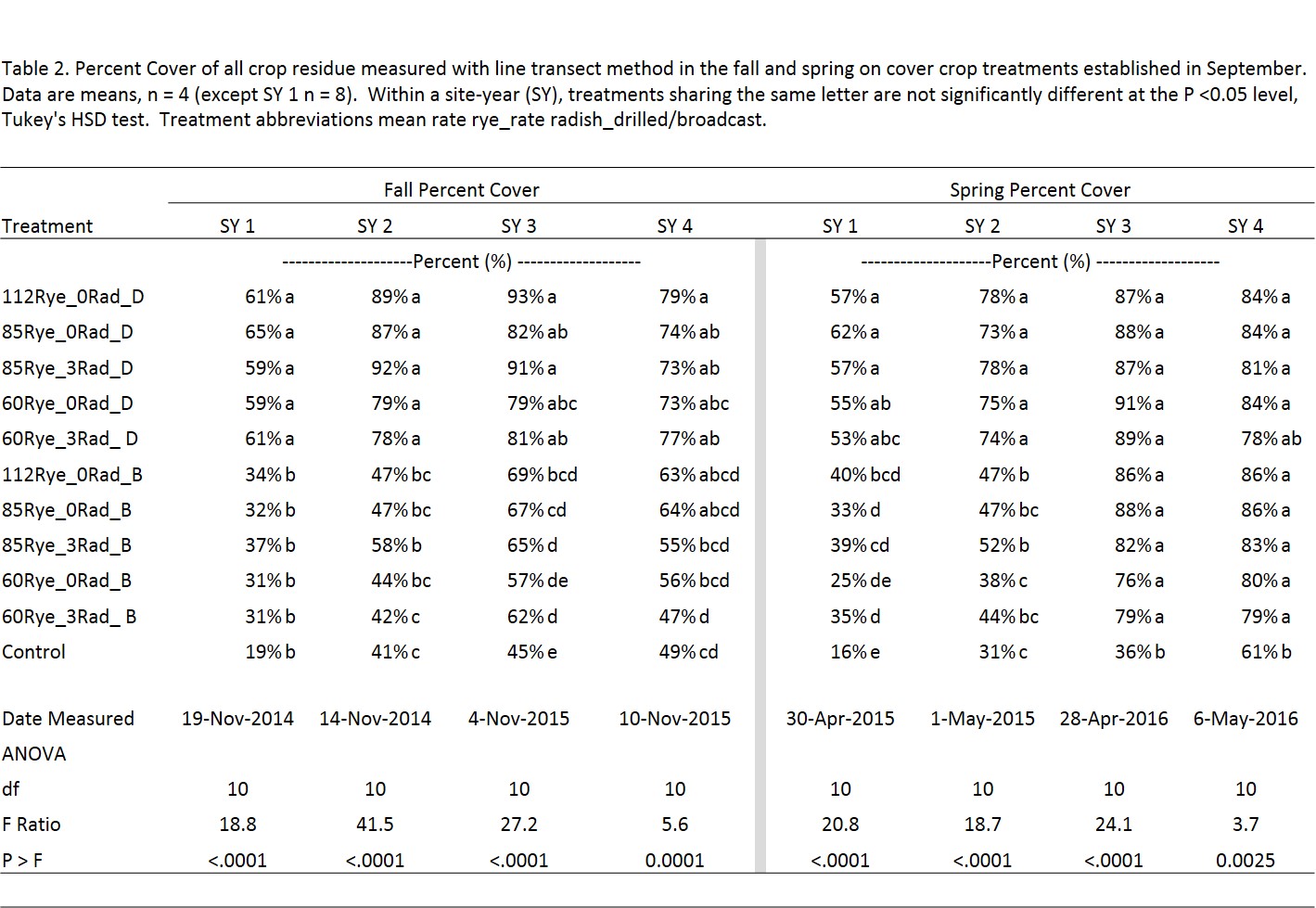 Table 2. Percent Cover (Fall & Spring) by Site-Year
Table 2. Percent Cover (Fall & Spring) by Site-Year
Table-2-and-associated-charts_Percent-Cover
The season seemed to also play a role, as SY 3 and SY 4, which covered the Fall 2015/Spring 2016 season had no significant differences between any of the cover crop treatments in the spring. They did perform significantly better than the control, however. Interestingly, in the fall measurements not all cover crop treatments performed better than the no cover crop control. In all site-years, there was at least one cover crop treatment that did not perform significantly better than the control in the fall. As expected, these treatments were always in the broadcast planting category. Even in the spring, all but SY 3 experienced the same phenomena. This seemed to be independent of tillage status prior to the experiment (no-till versus spring tillage). As in the biomass results, SY 3 and SY 4 saw the broadcast treatments ‘catch up’ in the spring as there was no significant difference between cover crop treatments in the spring, other than between all cover crop treatments and control. This, again, was due to the mild fall and winter experienced during that season. Percent cover measurements ranged from 19% to 93% in the fall and 16% to 91% in the spring.
NRCS generally uses this percent cover measurement to assess whether or not a field may meet the requirements for Residue Management (aka. Reduced Tillage). Interestingly, all Site-years except SY 1 had greater than 30% residue cover, even in the control plots in many instances. In many cases in SY 1 and SY 2, treatments actually saw a decrease in percent cover from fall to spring. Further investigation will need to be performed to determine if this is a significant difference.
Future Analysis
Poor establishment in the broadcast treatments drove both the biomass and the percent cover results. Plots were non-uniform, so when further analysis is done on treatment effects like soil moisture status, soil nutrient status and soil temperature, that analysis will be look at the drilled treatments only. They had uniform establishment, and with the these data quantifying that, it seems justified to narrow our focus for these other parameters that could be affected by the cover crop treatments.
We will also look at manure and whether we can determine whether the application of manure had any significant differences on cover crop performance. All sites were supposed to receive manure. One unexpected development was that SY 1 ended up having half of all the plots receive manure, while the other half did not receive manure. In addition SY 4 was unable to receive a manure application, due to timing of the custom operator and germination of the cover crops before they could get there to spread manure. We opted to withhold the manure, rather than risk damaging the new cover crop seedlings and/or applying manure at a later date out of sync with the other site-years. It will take further, more complicated analysis to determine if we can quantify differences based on whether or not treatments receive manure. Another confounding circumstance is that the applications of manure varied quite a bit with lowest rates well below target and the highest rates well above target of 5,000 gallons per acre. Again, this will take further analysis.
It is our hope to publish two papers as a result of this project in association with the Project Coordinator’s thesis. The first paper will focus on the agronomic factors of cover cropping: seeding rates, planting methods, establishment, percent cover and biomass production. The second paper will assess whether adding forage radish enhances a winter rye cover crop.
The biggest impact of the project has been the ability to share with producers the significant differences that result between drilling/planting a cover crop and broadcasting seed on the surface (even with manure spread on top). Many farmers and technical service providers who attended field days at the research sites, commented on the striking visual differences between the drilled plots and the broadcast plots. While UVM Extension has had no-till grain drills since 2012, the ability to show producers and service providers the difference with research plots on real farm fields seems to really driven that point home. In fact, one of the project partner farms is hoping to purchase a no-till drill in the near future to plant all of his cover crop and new hay seedings after seeing the results of this project on his own farm.
This project, along with many others has really driven farmer adoption. See the Farmer Adoption section for a detailed discussion.
This project, along with the Vermont NRCS Conservation Innovation Grant that recently concluded (Better Cover Crop Mixes for Vermont), has helped the Project Coordinator propose revised NRCS guidelines for cover cropping with multiple species. We will also propose to the State Agronomist that they might consider allowing lower seeding rates when drilling winter rye, especially under timely (early to mid-September) planting dates.
Education & Outreach Activities and Participation Summary
Participation Summary:
Education and Outreach was an important part of this project. A summary of the outreach events are detailed below.
Presentations
- 2015 Vermont No-Till and Cover Crop Symposium, preliminary project information was shared with the 170 attendees (71 farmers). (February 2015|Burlington, Vt.)
- Project information was shared with the 174 attendees (74 were farmers) at the 2016 Vermont No-Till and Cover Crop Symposium. Project Coordinator, Kirsten Workman, presented work from this project and other cover cropping projects in her presentation titled, “Multi-Species Cover Crop Mixtures”. (February 2016|Burlington, Vt.)
- A similar presentation was given at the New England Certified Crop Adviser In-service hosted by University of Maine Extension faculty and staff. Roughly 60 CCAs and University/Extension professionals attend this regional event. (February 2016|Portsmouth, NH)
- Jeff Carter, project participant/advisor, presented results from this project at a USDA National Institute for Agriculture professional development meeting in Virginia. The majority of this project is funded through USDA-NIFA project and Mr. Carter was presenting the work from that project, titled “Sustaining Rural Farm Communities in Vermont” (USDA-NIFA Award 2014-68006-21864). This project comprised roughly 25% of that presentation. (September 2016 | Virginia)
- Project information was shared with the 175 attendees (including 75 farmers) at the 2017 Vermont NO-Till & Cover Crop Symposium. Jeff Carter, project participant/advisor, presented a recap of research project results titled, “Research & Findings from the Field” that included a summary of the results from this project.
Field Days
- Soil Health Workshop & Field Day hosted by Champlain Valley Crop, Soil & Pasture Team (CV Crops) with 55 attendees (38 farmers, 10 service providers, 7 agency/govt./university), which included presentations and a field portion focusing on compaction and soil biology, utilizing cover crops to reduce phosphorus runoff, and the economic viability of cover crops. (April 2015 | Vergennes, Vt.) Event-Summary_SoilHealth_Hoorman_April2015
- A ‘Crop Patrol’ was hosted in conjunction with Champlain Valley Farmer Coalition (CVFC) at the Vorsteveld Family Farm (project participant) looking at the practice of injecting manure to incorporate broadcast seeding of winter rye, oat and radish cover crop following corn silage harvest. The event was attended by 6 farmers, 2 agriculture business representatives and 4 extension staff. (September 2015 |Panton, Vt.)Event-Summary_ManureInjectionDemo_9-15_2015
- A ‘Crop Patrol’ was hosted with CVFC at Cher-Mi Farm looking at several different mixes of cover crops including winter rye, barley, winter peas, and forage radish. There were 6 farmer, 2 agriculture business, 3 agency and 3 extension attendees. (October 2015 |Orwell,Vt.)Event-Summary_Cover_Crop_Mixes_10_23_2015
- The CV Crops team hosted a Fall Soil Health Workshop & Field Day at Foster Bros. Farm with guest speaker Ray Archuleta. The Project Coordinator presented preliminary project information during the morning classroom session and then led the field portion of the day looking at a related project with 16 different combinations of cover crops in demonstration plots. The event had 82 attendees with 40 farmers, 11 ag industry professionals, 17 agency staff and 14 Extension/University faculty/staff. (October 2015 | Middlebury, Vt.)Event-Summary_SH-Field-Day_Fosters_10-28-15
- A Cover Crop Field Day was held at the research plots located on Vorsteveld Farm. Eighteen (18) total attendees participated in the event which included seven (7) farmers and eleven (11) service providers, agency staff, and university faculty/staff. We discussed the project and focused a lot of the discussion on soil health and the difference between the broadcast plots and those that were drilled. An event summary and handouts from the field day are attached. (April 2016 | Panton, Vt.)Event Summary_CCFieldDay_Vorst_Spring 2016
- A Cover Crop Field Day for Technical Service Providers was held in May 2016. The field day was held at three different research projects, in four different fields at two different farms. One of the farms/fields was the research plots for this project at the Clifford Farm. In addition, NRCS Conservation Innovation Grant projects dealing with cover cropping, compaction and soil health were also highlighted. Twenty-three (23) people attended. Because this field day was specifically targeted to technical service providers, they made up the majority of attendees (22). Many NRCS and Vermont Agency of Agriculture staff, alongside local agricultural business representatives were able to have a good training looking at effective ways to implement innovative approaches to cover cropping. An event summary and handouts from the field day are attached. (May 2016 | Middlebury and Starksboro, Vt.)Event Summary_CCFieldDay_TSP_Spring 2016
Newsletters, Articles, Etc.
- In 2015, two CV Crops email newsletter issues featured articles about cover cropping written by the Project Coordinator. One (‘Learning As We Go’) focused on the importance of farmer participation in cover crop research and the other (‘Sponge or Stone: Cover Crops & Wet Weather’) looked at the role cover crops play in farm resilience in extreme weather. This newsletter is distributed to over 700 readers via email and another 425 through regular postal service. (July 2015 and October 2015)
- Spring 2017 Champlain Valley Crop, Soil & Pasture Team Quarterly Newsletter. “Cover Crops: From Research to Reality.” This article, written by the Project Coordinator highlighted multiple projects including this one. (http://www.uvm.edu/sites/default/files/CV-Newsletter-Spring.pdf)
Project Outcomes
An initial economic analysis of winter rye and forage radish cover crops performed during the development of this project revealed that there is an economic benefit to drilling a cover crop. The assumed costs used to make this comparison are outlined in Table 1. There are multiple options for planting a cover crop (see Table 2), but different planting methods require different seeding rates according to NRCS specifications. For example a winter rye/forage radish combination would require a rye/radish seeding rate of 85/4 pounds per acre if broadcast (without incorporation) or 60/3 pounds per acre if drilled or incorporated. In Table 3, which includes all the currently recommended/allowed seeding rates by Vermont NRCS, you can see that the drilled 60/3 pound per acre ends up being the cheapest option for the combination of winter rye and radish. It also is the cheapest of all the options, excluding radish alone. Within the radish only options, the broadcast only method would be the cheapest. However, it would likely not provide a desirable outcome based on what we see with broadcast only cover crops. For less than a dollar more, a very good radish cover crop can be drilled.

Table 1: Assumed Costs
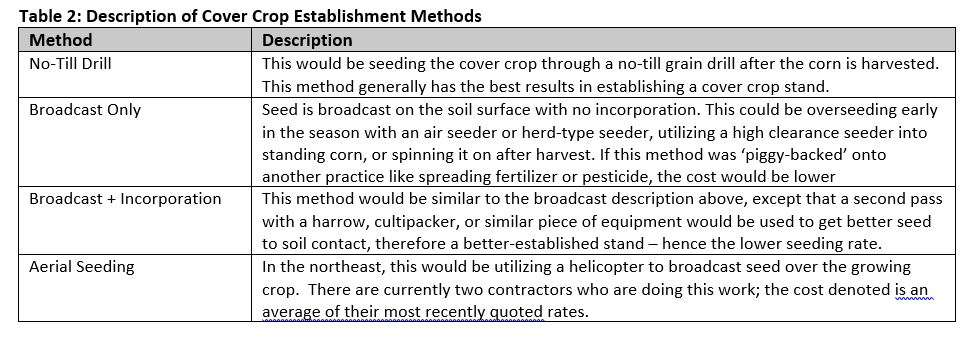
Table 2: Description of Cover Crop Establishment Methods
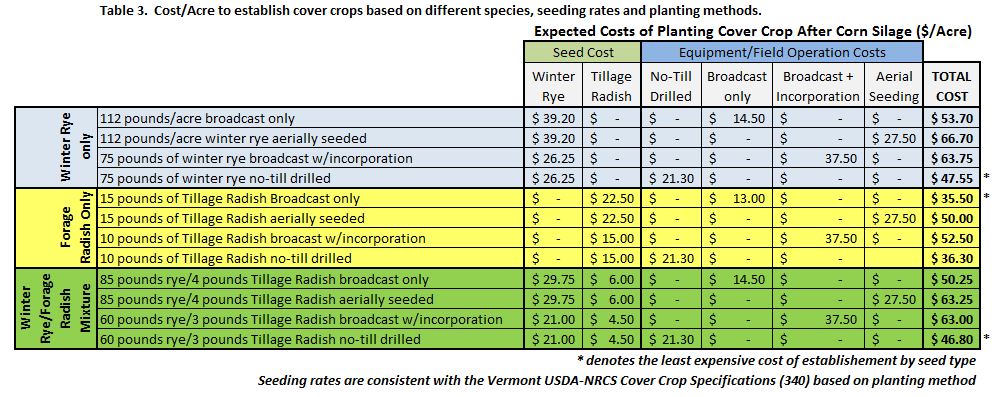
Table 3: Cost/Acre to establish cover crops based on different species, seeding rates and planting methods (in accordance with NRCS guidelines).
The cost per acre of all the treatments evaluated in this study is included in Table 4. The data from this study confirms that a drilled cover crop outperforms a broadcast cover crop and does justify a lower seeding rate. However, it justifies an even lower seeding rate than what is currently allowed under NRCS guidelines. In terms of biomass and percent cover, a 60 pound per acre seeding rate of winter rye alone performed as well as the higher seeding rates currently allowed. This could potentially save farmers $5.25 per acre if they were allowed to drill 60 pounds per acre winter rye instead of 75 pounds. For farmers not in a cost-share contract, this would be the preferred recommendation. In addition, this same 60 pound drilled winter rye would save $11.40 an acre over a 112 pound broadcast winter rye cover crop.
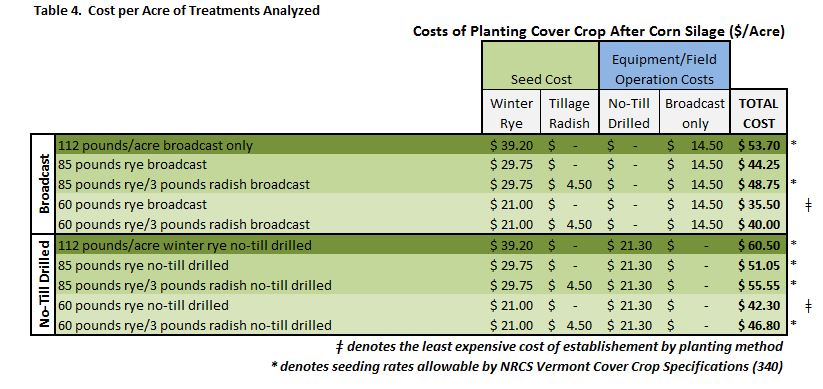
Table 4: Cost per acre of Cover Crop Treatments Analyzed
References:
Pike A.W. (2016) Pennsylvania's 2016 Machinery Custom Rates. USDA-NASS:3. (https://www.nass.usda.gov/Statistics_by_State/Pennsylvania/Publications/Machinery_Custom_Rates/2016%20Custom%20Rates.pdf)
Vermont NRCS Cover Crop (340) Specification Guide Sheet. USDA-NRCS eFOTG (https://efotg.sc.egov.usda.gov/references/public/VT/VT340_Specs.pdf)
Farmer Adoption
Farmers were an integral part of this project. The research happened on working dairy farms in Addison County. This was a vital component of encouraging farmer adoption. During a recent conversation with a farmer, he mentioned that he would have never cover cropped if I had been the only one to tell him he should try it. After attending a field day on one of the project partner farms, he spoke with that farmer and saw what they were doing and then he decided to try 30 acres of his own in the Fall of 2016. He indicated that he had only heard it from me, he wouldn’t have believed it because he knows I want farmers to cover crop. However, seeing it being adopted on a farm he respected helped him give it a try. We have found this to be true on several projects. In all, 98 farmers attended field days as a result of this project. More than 200 farmers heard information at workshops/conferences presented by project participants. As mentioned in the introduction, we have seen a rapid increase in adoption of cover crops in Vermont. During the project timeframe, we saw an increase of an estimated 10,000 acres of cover crops planted in 2014 to well over 25,000 acres in 2016. Of those, Champlain Valley Farmer Coalition farmer members, who are closely tied to the project team and have seen results from this project and others in the field, in presentations, and in articles written planted 9,100 acres of cover crops in 2016. In fact, 1,300 acres of those were planted by the project partner farms. While this is not solely correlated with just this one project, it is part of a larger effort underway in Vermont in partnership with NRCS, Vermont Agency of Agriculture Food & Markets, UVM Extension, farmer organizations, Conservation Districts and individual farmers.
Areas needing additional study
As more and more farmers adopt cover crops as a conservation and soil health practice on their farms, it will be important to study the management implications of adding these crops to a conventional rotation. In addition to the successful establishment of the cover crop itself, it will be important to quantify and analyze how to manage these cover crops in order to get the most benefit to the following crop. Studying termination strategies, in-season nutrient cycling during the cash crop season, managing residue to prevent it from becoming a nuisance in the subsequent crop and affecting germination and early season growth. It will also be important to study how adding these cover crops impacts nutrient management, P-Index ratings and manure nutrient cycling. For example, how does surface applying manure to a growing cover crop influence the availability of those nutrients during the cash crop season? If we want farmers to adopt this practice for the long-term, especially after cost-share funding is no longer available, it will be vital to understand and quantify the management strategies and impacts associated with their use.
Another area needing study is the utilization of shorter day relative maturity (DRM) corn hybrids that yield well in our northern climate on a variety of soils. We still find farmers reluctant to plant shorter day corn, due to perceived risk of yield loss. This can, however, be the lynch pin in getting a successful cover crop planted in a timely manner. In addition, it pushes corn harvest later in the fall when weather conditions get less reliable and soil conditions can be conducive to compaction due to harvesting in wet conditions.
Economics play an important role as well. A new Vermont NRCS Conservation Innovation Project starts just as this project ends to perform an economic analysis of cover cropping and reduced tillage systems in Vermont. A partnership between the Project Coordinator and UVM Extension Farm Viability staff, this will take our rudimentary economic analysis to the next level. This will be important to continue to see farmer adoption into the future.
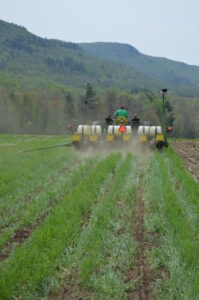
Project Participant, Eric Clifford, no-till planting corn into cover crop research plots (SY 2)